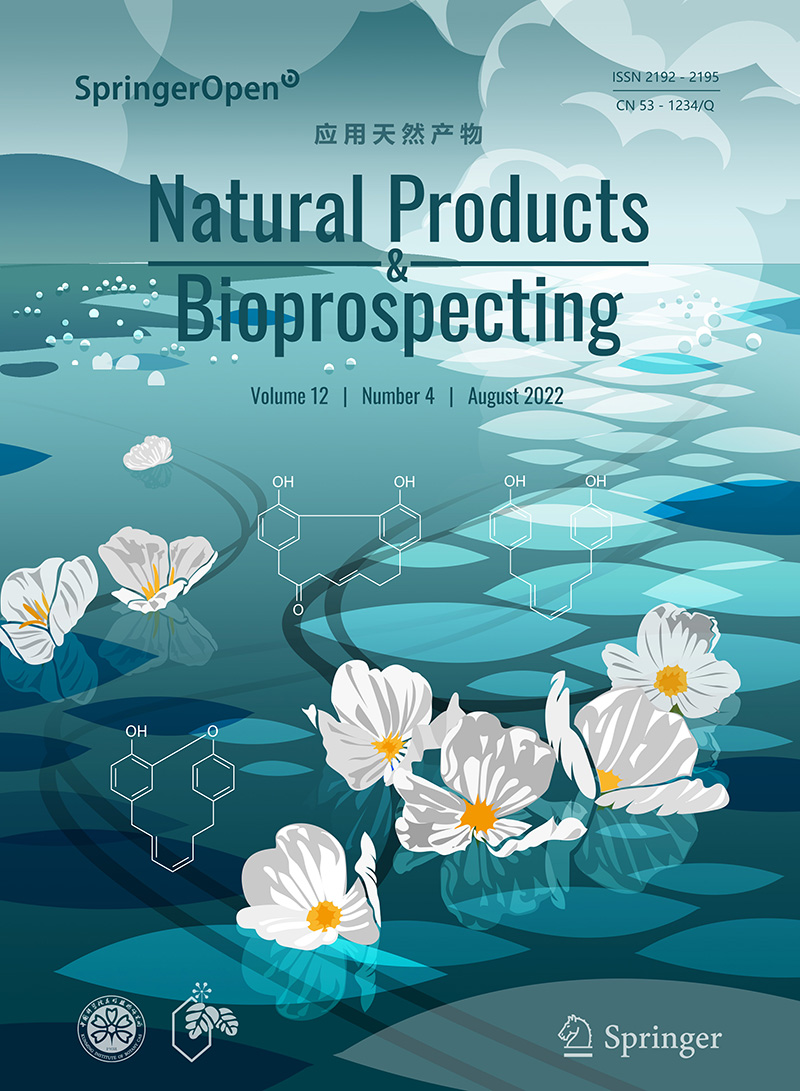|
|
α-Glucosidase inhibitive diarylheptanoids from Ottelia acuminata var. acuminata, a traditional vegetable of Bai Nationality in Yunnan
Collect
Hong-Xing Liu, Jun-Zeng Ma, Yan-Song Ye, Jian-Jun Zhao, Shi-Jie Wan, Xin-Yue Hu, Gang Xu
Natural Products and Bioprospecting. 2022, 12 (4): 22-22.
DOI: 10.1007/s13659-022-00341-4
Diabetes is an urgent health issue characterized by ethnic and regional variations, and is inseparable from the different dietary habits. It is worthy to note that the incidence of diabetes in Bai nationality has been reported to be much lower than Han in China. As a daily vegetable of Bai, the phytochemical and antidiabetic study of Ottelia acuminata var. acuminata had not been carried out. In this study, 41 metabolites with diverse diarylheptanoid (six new ones, Otteacumienes A-F), flavone, sesquiterpenoid, coumarin, lignan, polyacetylene, and alkaloid skeletons were characterized from O. acuminata var. acuminata. Among them, the racemic nature of 3 was characterized by chiral resolution and calculated ECD methods. The biological study revealed diarylheptanoids showed significant α-glucosidase inhibitory activities with 5 as the most effective one (60-fold stronger than acarbose). Molecular docking studies indicated that these structures have different binding cavities with acarbose. This study demonstrated that O. acuminata var. acuminata might correlated with the low incidence diabetes of Bai and the diarylheptanoids may have potential therapeutic value for diabetes mellitus.
References |
Related Articles |
Metrics
|
|
|
Chemistry and bioactivities of natural steroidal alkaloids
Collect
Mei-Ling Xiang, Bin-Yuan Hu, Zi-Heng Qi, Xiao-Na Wang, Tian-Zhen Xie, Zhao-Jie Wang, Dan-Yu Ma, Qi Zeng, Xiao-Dong Luo
Natural Products and Bioprospecting. 2022, 12 (4): 23-23.
DOI: 10.1007/s13659-022-00345-0
Steroidal alkaloids possess the basic steroidal skeleton with a nitrogen atom in rings or side chains incorporated as an integral part of the molecule. They have demonstrated a wide range of biological activities, and some of them have even been developed as therapeutic drugs, such as abiraterone acetate (Zytiga®), a blockbuster drug, which has been used for the treatment of prostate cancer. Structurally diverse natural steroidal alkaloids present a wide spectrum of biological activities, which are attractive for natural product chemistry and medicinal chemistry communities. This review comprehensively covers the structural classification, isolation and various biological activities of 697 natural steroidal alkaloids discovered from 1926 to October 2021, with 363 references being cited.
References |
Related Articles |
Metrics
|
|
|
Pharmaceutical and nutraceutical potential of natural bioactive pigment: astaxanthin
Collect
Apurva D. Patil, Pramod J. Kasabe, Padma B. Dandge
Natural Products and Bioprospecting. 2022, 12 (4): 25-25.
DOI: 10.1007/s13659-022-00347-y
Astaxanthin (3,3'-dihydroxy-β,β-carotene-4,4'-dione) is an orange-red, lipophilic keto-carotenoid pigment. It is majorly found in marine ecosystems particularly in aquatic animals such as salmon, shrimp, trout, krill, crayfish, and so on. It is also synthesized in microalgae Heamatococcus pluvialis, Chlorococcum, Chlorella zofingiensis, red yeast Phaffia rhodozyma and bacterium Paracoccus carotinifaciens. Some aquatic and terrestrial creatures regarded as a primary and secondary sources of the astaxanthin producing and accumulating it through their metabolic pathways. Astaxanthin is the powerful antioxidant, nutritional supplement as well as promising therapeutic compound, observed to have activities against different ravaging diseases and disorders. Researchers have reported remarkable bioactivities of astaxanthin against major non-communicable chronic diseases such as cardiovascular diseases, cancer, diabetes, neurodegenerative, and immune disorders. The current review discusses some structural aspects of astaxanthin. It further elaborates its multiple potencies such as antioxidant, anti-inflammatory, anti-proliferative, anti-cancer, anti-obese, anti-diabetic, anti-ageing, anti-TB, anti-viral, anti-COVID 19, neuro-protective, nephro-protective, and fertility-enhancing properties. These potencies make it a more precious entity in the preventions as well as treatments of prevalent systematic diseases and/or disorders. Also, the review is acknowledging and documenting its powerful bioactivities in relation with the pharmaceutical as well as nutraceutical applicability.
References |
Related Articles |
Metrics
|
|
|
Drimane sesquiterpenoids from a wetland soil-derived fungus Aspergillus calidoustus TJ403-EL05
Collect
Sitian Zhang, Shuyuan Mo, Fengli Li, Yaxin Zhang, Jianping Wang, Zhengxi Hu, Yonghui Zhang
Natural Products and Bioprospecting. 2022, 12 (4): 27-27.
DOI: 10.1007/s13659-022-00349-w
Soil-derived fungi represent an insufficiently tapped reservoir for discovering new and bioactive natural products (NPs), and despite an ever-increasing number of unknown NPs have been discovered over the past few decades, much of the hidden biosynthetic potential is still in an urgent need to be disclosed. In this research, a chemical investigation was performed on a wetland soil-derived fungus Aspergillus calidoustus TJ403-EL05, leading to the isolation of a total of fourteen drimane sesquiterpenoids (1-14), incorporating three new ones, namely ustusols F-H (1-3). Their structures, comprising absolute configurations, were completely authenticated by widespread spectroscopic data, quantum chemical 13C NMR and ECD calculations, and X-ray crystallography experiments. Compound 14 exhibited moderate anti-inflammatory activity by inhibiting the LPS-induced NO release (IC50=25.6 μM).
References |
Related Articles |
Metrics
|
|

